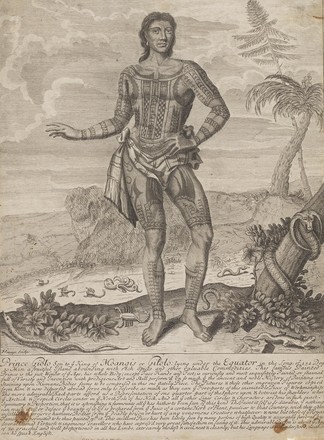Prince Giolo or Jeoly
By Richard Neville, 2010
The resurgent interest in tattooing in western society
today sees it being embraced as a kind of skin bling for celebrities, sports
people and the fashionable. Its reintroduction to the West is often attributed
to an interest in the Polynesian tattoos encountered by the sailors on Captain
Cook’s Pacific voyages – and, indeed, tattoo is derived from a Polynesian word.
But nearly a century before Cook’s crew encountered
Polynesian tattoos, British adventurer William Dampier purchased in what is now
Indonesia a half-share in the heavily tattooed Jeoly. Decorated in a tribal
design, Jeoly came from the island of Miangas, close to the Philippines, and
Dampier’s initial interest in him was his possible knowledge of local reserves
of spices and gold.
After Jeoly failed to deliver these, Dampier saw the
potential in his ‘Painted Man’ being exhibited as a curiosity in England.
Returning with home to London in 1691, Dampier wrote, ‘I was no sooner arrived
in the Thames, but [Jeoly] was sent ashore to be seen by some eminent persons;
and I being in want of Monday, was prevailed upon to sell … my share in him.’
Prince Giolo was commissioned to promote this ‘Just
wonder of the Age’. The pose of a typical European gentleman in the engraving
emphasises Jeoly’s alleged royal status. His striking tattoos ‘full of variety
and Invention with prodigious Art and Skill’ were said to have powers to repel
snakes, which are seen fleeing his presence in the print, although Dampier
himself noted that Jeoly was as scared of snakes as he was.
While Jeoly met the King, he also found himself being
exhibited in the Blue Boar’s Head Inn in Fleet Street. He was then taken to
Oxford where he soon died of smallpox. A curiosity even in death, an Oxford
surgeon removed his skin and presented it to the University’s Anatomy Museum.
It has not survived.



 Back to list
Back to list